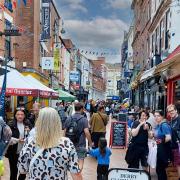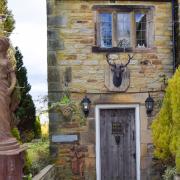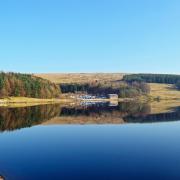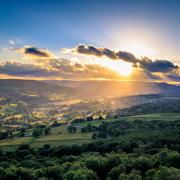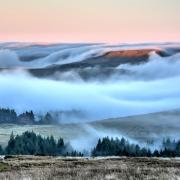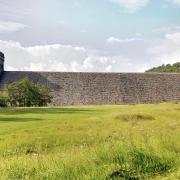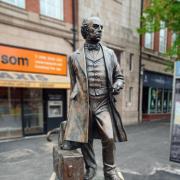Some interesting facts about Derbyshire are indisputable.
Buxton, for example, is England’s highest market town and the Peak District is the oldest national park in the UK.
Yet can our county lay claim to England’s smallest village? Here, the case is less black and white.
To find the answer we must head to Ault Hucknall, which lies some four miles south of Bolsover.
The parish of Ault Hucknall first appears in the records of 1291, including the Doomsday settlements of Astwith, Hardstoft, Rowthorne and Stainsby.
Also included are the bigger villages of Glapwell, Bramley Vale, Doe Lea, joined together by the houses lining Glapwell Hill.
There are also more outlying areas to the parish such as Timber Lane, not to mention Hardwick, home to the majestic Hardwick Hall.

The parish contains 23 listed buildings, with three commanding Grade I status – Hardwick Old Hall, Hardwick Hall, and the 11th century St John the Baptist Church.
It is the latter building which appears to be at the heart of whether Ault Hucknall can truly claim to be England’s smallest village – more on that shortly.
‘Parish’ appears to do a lot of heavy lifting here, so just what is the argument for Ault Hucknall fitting the description of England’s smallest village?
The debate centres on just three properties and a church and whether or not this gives the area village status.

And there are plenty who will suggest it does.
‘Ault Hucknall is often described as being the smallest village in England,’ muses Derbyshire Heritage (derbyshireheritage.co.uk); ‘Ault Hucknall is a scattered village and a parish in Derbyshire’ suggests the UK Genealogy Archives.
Not all, though, are convinced at this possibly dubious claim to fame.
‘I have lived here for many years and we don’t actually have a village or hamlet called Ault Hucknall,’ Ann Syrett, chair of the Ault Hucknall Parish Council tells me.
‘Doe Lea and Bramley Vale - adjoining ex-pit villages - are where most people live and where the primary school is. It’s mainly farmland here and there are several hamlets as well as scattered groups of two or three houses - like the ones round the church.
‘The area around the church is always referred to as Ault Hucknall as the road sign suggests, but it isn’t known as Ault Hucknall village locally or even as a hamlet for that matter.
‘It’s an interesting area with a history going back a long way before its Norman name, but I don’t think we can claim to be England’s smallest village.’
So, if not Ault Hucknall, what is England’s smallest village?

Whitwell, in Rutland, has a strong case, containing just 19 houses, a pub and a church. At the last count, it was home to just 41 residents.
However it is the presence of a church in Whitwell which, technically, makes it a village and not a hamlet which begs the question – does that not make Ault Hucknall a village too?
George Hadley, who runs villageandcottage.com, makes very specific claims into just what constitutes a village.
‘In British terminology, a village is a small collection of houses with a church,’ he argues. ‘A hamlet is the smallest recognised settlement in British geography. It can technically be a single house, but it’s more commonly used to define a small, rural hamlet settlement that lacks the specific characteristics of a village.
‘Specifically, hamlets don’t have churches, administrative buildings, or village halls. If they have these features, they’re a village.’
‘There are three elements to Ault Hucknall: the village of Ault Hucknall; the administrative district of Ault Hucknall (relating to the Parish Council) and the church, plus its parochial area,’ Dr Allan Voice, churchwarden and chairman of the Parochial Church Council, St John the Baptist, tells me.

‘The presence of the church at Ault Hucknall allows the village to claim to be the smallest village in England: it comprises the church and three houses. Without the church, it would be a hamlet.’
Whether a village, a hamlet or something else, the area surrounding the church is charming to say the least, including picture postcard stone cottages boasting mullioned windows and fabulous floral displays set against sprawling countryside.
The church, though, is undeniably the centrepiece – a mainstay of life here for generation after generation.
‘The church of St. John the Baptist has stood on a wooded hillside in Ault Hucknall for more than 1,000 years. It is of national importance, being a Grade I listed building,’ continues Allan.

‘In the fields surrounding the church can be seen evidence of the once existing village, abandoned as so many were, following the Black Death.
‘The name of Ault Hucknall is thought to be a compound of the French ‘haute’, meaning ‘high’, and a personal name of Saxon origin, Hucca. The parish is referred to in the Doomsday Book and the Church’s Saxon and Norman origins are attested to by the tympanum and a lintel dating from the 11th century.
‘Ancient parts of the church include the beautiful narrow arch between the chancel and the sanctuary, the two large arches to the north aisle, a small loop window in the north wall, and the large arch between the nave and the Chancel.
‘It is rumoured some of the stone used in its construction originated from the site of the old Roman fort which gave Chesterfield its name; this also being the site of the current St. Mary’s church.
'Worship at St. John the Baptist church is traditional. There is a fortnightly Sunday morning communion service using common worship in traditional language. The congregation is derived from the surrounding villages and indeed from further afield in view of its beautiful situation and character.
'Festivals are celebrated and therefore there are midweek services on occasions such as Ash Wednesday, Maundy Thursday or Ascension Day. Good Friday is usually observed with an act of Worship at Ault Hucknall and, traditionally, an Advent Carol Service and Nine Lessons and Carols at Christmas. Harvest Festival is also an important festival for the rural community.'

If Ault Hucknall is indeed a village, it’s one that certainly punches above its weight in terms of notable figures associated with it and its historic place of worship.
‘The famous philosopher Thomas Hobbes, author of Leviathan, is buried in the church,’ reveals Ann.
‘He was buried there because he tutored the Dukes of Devonshire and is reputed to appear in the church on the night one of them dies.
‘Apparently he appeared to a vicar many years ago, which is how the story started, but the recent vicar couldn’t be persuaded to test it last time round!’
The Latin inscription on the black marble slab within the church reads:
‘Here are buried the bones of Thomas Hobbes of Malmesbury, who for many years, served the two Earls of Devonshire, father and son. A sound man and well known at home and abroad for the renown of his learning. He died in the Year of our Lord 1679 on the 4th day of the month of December in the Ninety first year of his age.’
‘Hobbes had a long-standing connection with the Devonshires, dying at Hardwick Hall in 1679,’ adds Allan.
‘Many visitors and students of philosophy come each year not only the UK but from around the world to visit his tomb.’

The church is also the resting place of Anne Keighley, the 1st Countess of Devonshire, which is particularly unusual given members of the Cavendish family were generally buried at Edensor on the Chatsworth estate.
The inscription on her tomb reads:
‘In this tomb, under the figures of Modesty, Prudence, Love, Obedience and Piety and of the subsidiary and guardian virtues, are placed and preserved the ashes of a most excellent woman, Ann Keighley, daughter and heiress of Henry of Keighley, in the Count of York, Knight. She married the exalted nobleman, William Cavendish, Knight of Chatsworth, (afterwards raised to the Earldom of Devonshire) and bore him three sons, Gilbert, William and James, and as many daughters, Mary, Elizabeth and Frances. James, the youngest, sleeps beside his mother. William, Earl of Devonshire and Lord of Hardwick, the heir and now the only survivor, who wishes to preserve at the same time the memory of his dearest mother and brothers and sisters, had this monument made.’
A further connection to the Devonshires can be found in the churchyard in the form of a gravestone, which reads:
‘In Memory of Lexey Mallinson, Servant to his grace the DUKE of DEVONSHIRE at Hardwick, who died Aug 15th 1799, Aged 66 Years'.
The Bolsover district parish of Ault Hucknall is a proud, fascinating and friendly one. Indeed, I can hardly recall a group of people who have been more accommodating or helpful when it comes to putting together a feature on a place in Derbyshire.
As of the 2021 census, the parish was home to some 1,300 residents, with the area comprising 33 detached, 44 semi-detached and 41 terraced properties.

Yet it is just three of these properties – plus the church, which continues to thrive as a communal place of worship – that provides the focus when it comes to determining whether Ault Hucknall can genuinely lay claim to being recognised as England’s smallest village.
Many will argue that in the grand scheme of things it doesn’t really matter. It is, after all, the people and places that matter – not a title. And Ault Hucknall has these in abundance.
‘The parish of Ault Hucknall has a warm feel to it within the many small communities,’ concludes Allan.
‘People feel they know and are known to their neighbours throughout the parish and we have such rich variety all within our boundaries.’
Whether or not the Rutland village of Whitwell has competition in the form of our very own Ault Hucknall is probably a moot point. But it’s an interesting debate nevertheless.





